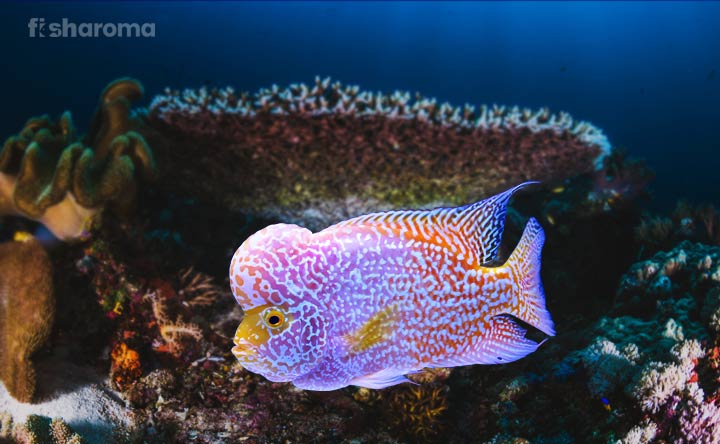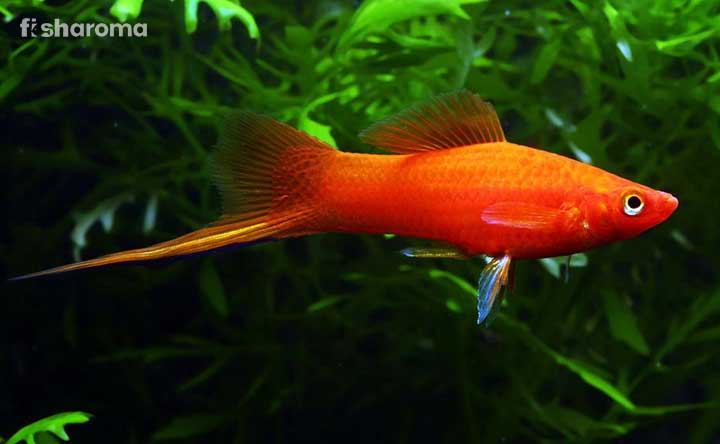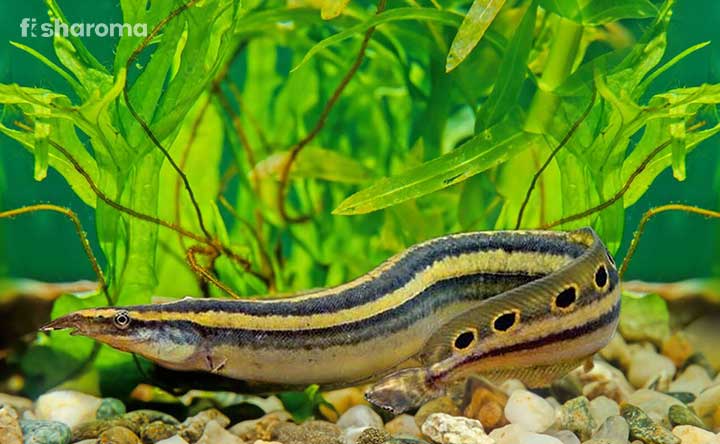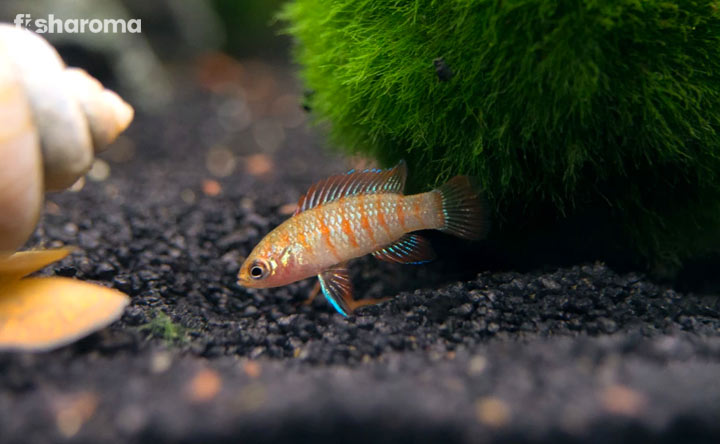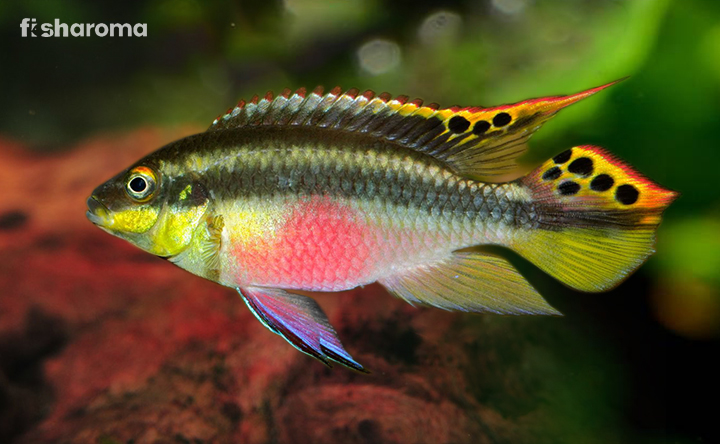The Complete Care Guide of Bichir Fish – The Living Fossil of Freshwater
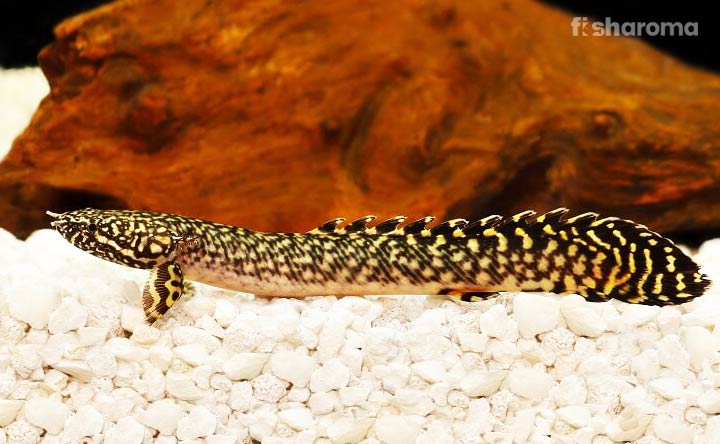
Keeping rare species in the aquarium has become a trend and when the rare species has an Eel-like structure it becomes a pleasure for aquarists. Sounds interesting? Not just interesting! You can get a pre-historic feel when the rare species is Bichir.
It has an extraordinary appearance and nature and it comes with a medium to difficult care level. That’s why we are here to make the task of caring easier for you.
Key Specifications of Bichir
| Scientific Name | Polypteridae |
| Family | Polypteridae |
| Origin | Tropical Africa |
| Size | 15-30” (38.1-76.2cm) |
| Color | Depends on the variants |
| Care Level | Medium to difficult |
| Lifespan | 15-20 years |
| Temperament | Semi-aggressive |
| Compatibility | Low |
| Tank Size | 70-90 gallons |
| Diet | Carnivore |
Overview
Bichir belongs to Polypterus genus which means ‘many wings’ and it is truly applicable to the looks of this fish. It is from the family of ray-finned fish which was first seen in the Mesozoic era (approximately 60 million years ago).
This bottom-dweller has poor eye-sight in general; maybe that’s why it is given excellent sensory organs which help them in all their activities in captivity and in the wild. Though they are deprived of their vision, it has an excellent sense of smell.
Origin and Habitat of Bichir
Bichirs are originally from Northeast Africa, specifically the entire basin of the Nile including its tributaries. Traces of this fish are also seen in India too.
They can survive in a low level of water in nature as they can breathe from the air because of their functional lungs. Bogs, dark areas, floodplains, and estuaries are their favorite places because of the shallow and muddy water.
Appearance of Bichir
You will be able to find resemblance of Bichir with any prehistoric fish that have changed a lot due to the natural evolution. It still bears some characteristics of the ancestors (other ray-finned fish like Lungfish) and developed some new characteristics – this is the reason behind their uniqueness.
Scales of this fish are thick like bones and its pectoral fin is fleshy. It is claimed that it can stay out of water for some time in case its scales are wet. In the natural habitat, these scales shield the fish from all types of danger. If you look closely, you will find that the scales are diamond-shaped and joined flexibly.
It looks much like a combination of snake and Eels, but with a row of spiny dorsal fins. Their pectoral fins are paddle-shaped and you can see its nostrils (Spiracles) clearly which compensates their poor eyesight. Their dorsal fins are a combination of 5-18 small fins.
Size of Bichir
Based on the different variants, the sizes of Bichirs differ. On average, they are 15-30” (38.1-76.2 cm) and females are slightly larger than the males. Also, the anal and dorsal fins of the females are wide and thick in females though it is not easy to identify.
Color of Bichir
Just like the size, the color of this fish also depends on their types. Grey, yellow, and white are the commonest colors and you will find multiple patterns on their body and fins.
Types of Bichir
Based on the color and sizes, followings are the most popular types of Bichirs for aquarium trade:
Dinosaur Bichir
Dinosaur Bichir (Polypterus Senegalus) is widely popular among the aquarists and it is also known as Reed Fish, Swamp Dragon, Dinosaur Eel, Senegal Bichir, and Grey Bichir. Platinum Senegal Bichir is the latest discovery and it is a very popular one from this type. Albino Bichir is also very popular among the Dinosaur Bichir because of their red eyes.
It has a cylindrical body and you can find it in grey, white, blue and pink. Its pectoral fin is quite large and dorsal fins are serrated. It is the smallest Bichir that grows 14” (35.5 cm).
Saddled Bichir
Keeping a Saddled Bichir is like a pleasure for the aquarist because of its appearance. It has a white body with dark-colored vertical bands across the body. Plus, its lower jaw is longer than its upper jaw which is truly unique. Apart from its appearance, another reason for its popularity is its length – it is the largest Bichir that grows 30” (76.2 cm).
Ornate Bichir
Ornate Bichir or Polypterus ornatipinnis is famous for the combination of dark and light colors in its body. Bright yellow patterns on the dark brown body make it more attractive, this is why aquarists often opt for this fish. The length of this fish is 24” (60.96 cm) and sometimes the dark brown color of their body turns grey.
Delhezi Bichir
It looks much like its sibling Ornate Bichir, but a close look will reveal that Delhezi Bichir or Polypterus delhezi has a greyish body with green spots. The spots sometimes turn yellow which enhances its looks.
Behavior of Bichir
Bichirs are semi-aggressive fish and because of their predatory nature, they eat small fish in an aquarium and in nature. Apart from the looks, you will find uniqueness in its nature too as it can walk. At the time of walking, they look much like the reptiles. Actually their pectoral fins move around which can help them walk.
As it is a bottom-dweller, aquarists often thought that they are swimming above the substrates, but actually, they walk there. It is a sign of their ancestors who actually used to have hands and legs to walk which transformed into fins and tails in this fish.
Lifespan of Bichir
In nature, it lives up to 20 years, but, if you can provide them with accurate nutrition and healthy tank conditions, they can live up to 15-18 years in an aquarium. So, you must have the mentality to bear a long term responsibility as it lives for 18 years.
Proper maintenance of aquarium and diet can maximize the lifespan to 20 years easily. You can go to the next section to know what to feed this unique fish!
Diet of Bichir
They are a predator in their natural habitat and prey on vertebrates, crustaceans, insects and other small fishes. You can replicate the same in the aquarium too by feeding them live food, and not just pellets and help them to maintain their predatory behaviors.
Even though you choose store-bought foods, make sure it is high in protein. It is a carnivorous fish and it enjoys all types of meaty food like Bloodworms, frozen Shrimps, Krill, Calamari, Weather Loaches, Earthworms, small fish, Nightcrawlers, and Ox-heart.
You will need to determine the quantity of food from the experts or from the pet store at the time of buying as its dietary habits are slightly different from other omnivorous fish for aquarium.
It is a nocturnal feeder, so turn off the lights right after their food sink to the bottom of the tank. Don’t worry! They will smell the food or sense the flow of water after dropping the food.
Tank Requirements of Bichir
That’s all about their diet, but along with healthy food, they need a well-maintained tank too. Let’s take a look at its tank requirements:
Tank Size
As you have seen that it is a quite large species, you will need a large tank for the adult ones. A 90-gallon tank will be a good choice for this fish.
It needs a spacious tank as a high-protein diet provides it a lot of energy and it swims around all day. It does not matter if you are petting this fish singly; you need to provide the space to swim.
So whenever, you are planning to keep a Bichir, go for a large tank.
Tank Lid
A tight lid is important because they can crawl up the aquarium wall and jump from large aquariums. But make sure the lid has some holes which can allow them to get oxygen from the air.
Substrate
Sand will be the accurate substrate and you have to avoid any types of the sharp-edged substrate as all these may hurt the belly of this bottom dweller. Sandy substrate also helps them during their walk too.
Some aquarists often prefer gravel substrate, but that is not good for them because it can consume the gravels at the time of eating the food that falls on the gravels.
Aquatic Plants
Plants are important here not for oxygen or food, but to provide this fish cover from light, so you can use the floating plants like Water Lettuce. But keep in mind that the entire surface area must not be covered by the plants. Plants are desirable, not mandatory.
Aquarium décor
This fish does not mess with decors or plants, so you are free to use decors like driftwood, snags, stones, castles, caves, ceramic and plastic tubes or anything as per your choice.
Filter
They generally don’t have any requirement for filtration as they survive well in low oxygenated water. However, aquarists prefer to install a standard filter to clear up the toxic materials.
As they will intake more live foods, the chances of leftover food will be higher here, so don’t skip a filter. You can go for a canister or a biological and a mechanic filter if you wish to keep the tank clean.
Water Type for Bichir
You will need to maintain the quality of water too along with proper tank setting:
Temperature, pH Level and Hardness
Water Temperature should be between 72-82°F (22.2-27.7°C) with neutral pH 6.5-7.5. They stay in soft water, so set the hardness at 5-20 dKH.
Cleaning
As it is a bottom feeder, you definitely need to look for the fast sinking foods that possibly stick to the sandy substrates. Also, it is a messy eater and it can make the tank dirty within a few days, so be careful about that.
You can use scrubbers to clean this but beware of using any chemicals or soap. At the time of cleaning, make sure you siphon out fish excretes, along with remaining food particles which may convert into nitrate later.
Water Change
Aquarists often develop the habit of not changing the water as it is an extremely hardy fish. If you want this fish to stay longer, 10% water change is necessary every week. It’s better to get a water testing kit to provide a healthy life to this fish.
Compatibility of Bichir
If you want, you can keep multiple Bichirs together, but you will need larger tanks for that. Don’t worry, they will not mess. If you can manage more than one, it will be alright to keep.
Do you think that a single Bichir in a 90-gallon tank will look too dull? Well, you are wrong, it will be a pleasure, but if you want to add this fish in a community tank, the following part will help you.
Suitable Tank Mates of Bichir
Any large fish will be alright to keep here, just make sure that its tank mates are adult enough and do not fit in the mouth of Bichir. Because of the shortage of space in an aquarium, it can be territorial to its tank mates. So if you are planning to place this fish in a small tank, you may need to reconsider this.
The most compatible tank mates for a Bichir are:
- Oscar Fish
- Large Parrotfish
- Silver Dollar
- Green Terror Cichlid
- Knifefish
- Large Catfish
- Large Clown Loach
- Jack Dempsey
- African Cichlid
- Large Barbs
- Flowerhorns
Though the list of compatible fish is quite large, these fast-swimming tank mates can steal the food of Bichir. As a result, it will die of starving, unless you are extremely careful about this.
Unsuitable Tank Mates of Bichir
Any small fish or invertebrates are nothing, but the food of Bichirs in nature. Indeed, because of their predatory behavior, they will consume small tank mates and nip their fins and tails too. So avoid the following species:
- Tetras
- Danios
- Bettas
- Scarlet Badis
- Shrimps
- Snails
Breeding of Bichir
Captive breeding of this fish is still under experiment and a few types (not all) have given successful results too.
Actually, their requirement at the time of breeding is still unknown and it is hard to identify males and females – that’s another reason behind unsuccessful breeding.
At present, Bichirs in the pet stores are caught in the wild and it is assumed that they survive 12-15 years as they initially struggle to cope up in captivity. If it becomes possible to breed them in captivity, it might be possible to maximize their lifespan.
Common Diseases of Bichir
Due to the negligence of the fish-keepers, it may fall sick, however, they are not prone to any specific disease. Common freshwater fish diseases can be seen in them because of the improper maintenance of tank and water.
Flukes are quite common in this fish and whenever you notice fine thread-like objects in its body, be careful and consult an expert.
Ich is also a common disease of the fish and if you find the fish rubbing its body against the substrates, be sure that there is something wrong with its health. You can cure all these diseases by slightly adjusting the temperature and applying solutions or by taking the medical help of a veterinarian.
They are affected more by parasites as they consume so much meaty food; so, get a reliable source of food. Also, get this fish from a reliable pet store because these stores sell the wild-caught ones that are often affected by tapeworms.
Difficulties in Petting the Bichir
It is a fish that comes with a medium to difficult care level and it is not a fish for beginners because of its food preferences and nature. After reading its care guide, you have probably understood that. Apart from that, maintaining such a large tank can be an issue too.
Summary
Bichir is unique in looks and behaviors, and it is also true that you will need to be a master of fishkeeping to keep this fish. You need to be a good observer to identify any parasite at the time of buying and later in this fish to reduce the chances of health issues.
We can’t deny that it has a different appeal to the fish-keepers because of its looks and you can go for it, if you have enough experience, and a large tank. You can get this fish too if you want to have the feel of keeping a living fossil in your aquarium.
So, are you ready to accept the challenge of keeping a fish that have gone through an evolution and has signs of prehistoric and modern fish altogether?
Interesting Facts About Bichir
- The reason for the poor eyesight of the Bichirs is their dark habitats in nature.
- It can bite you if your finger is too close to it and its bite will hurt a lot.
- Don’t worry, if you can’t find the fish at the bottom of the tank! It is probably hiding under the driftwood.
- You may sometimes find the fish sleeping during the day, but their eyes don’t get shut off then. If you find the water is still, be sure that it is sleeping.
Some More Unique Freshwater Fish:
If Bichir appeared interesting to you and you felt that it is worth keeping in your freshwater tank, the following ones may interest you too:- Rope Fish: If you are willing to pet a fish that looks unlike your previous aquatic buddies, get a Rope Fish. In the care guide, you will get the answer to all your queries regarding this fish.
- Kuhli Loach: Do you want a fish with unconventional looks? What if that exceptional-looking fish is damn peaceful? Sounds unbelievable? Kuhli Loach will make you believe all these. You can go through its care guide.
- Black Ghost Knifefish: Be a part of the trend of keeping rare species in freshwater aquarium with Black Ghost Knifefish and get ready to amaze everyone. For all sorts of caring tips, here is the care guide.

